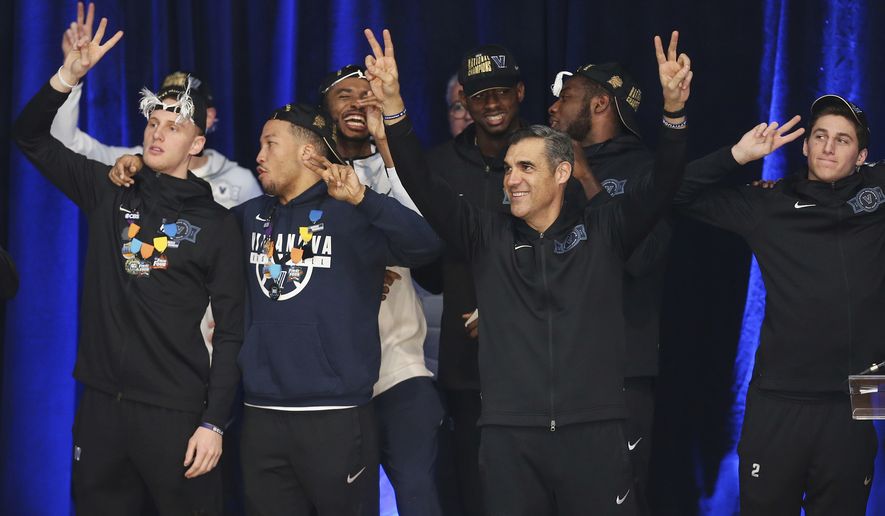Tourney was momentary distraction from money-driven process

By DERON SNYDER (as published in The Washington Times)
Well, that was nice.
Villanova won the NCAA men’s basketball tournament with an old-fashioned college team, nary a one-and-done in sight. Vanquished Michigan was constructed in similar fashion by John Beilein, voted the sport’s cleanest coach in a CBS poll of 100 coaches last year.
Loyola Chicago, which hasn’t produced an NBA player since 1987 – Andre Moore, whose career totaled one season, two teams and 10 games – reached the Final Four despite being an 11-seed. And in the tournament’s most heart-warming story ever, UMBC made history by advancing as a 16-seed.
It was almost enough to make you think the tourney is played by nonprofessionals.
Technically, that’s correct. Every player who stepped on the court is an amateur, from UMBC’s 5-foot-8 guard K.J. Maura, to Arizona’s seven-foot center (and potential No. 1 draft pick) DeAndre Ayton. They are student-athletes who play for love of the game, while receiving scholarships in return.
That’s what separates college players from NBA players. That’s where NCAA president Mark Emmert and his accomplices want us to focus. That’s why the championship run by Villanova and Michigan’s was so vital as the FBI probes.
Did you see NFL Hall of Famer Jerry Rice during the tournament? He appeared in an NCAA TV commercial, “Opportunity,” that aired several times. It’s part of the organization’s longstanding effort to divert attention from the folks counting money behind closed doors.
“There are over 480,000 college athletes,” Rice says, as highlights show him hauling in touchdown passes with the San Francisco 49ers. “Only two percent will go pro.”
Let’s stop right there. This is a favorite ploy, acting like prospects for most athletes justify the current system of “amateurism” in revenue-producing sports. Actually, one has nothing to do with the other. Whether 100 percent or none go pro, we’re talking about what happens in college, not afterward.
OK, Jerry. Please continue.
“That means over 470,000 will not get a shoe contract,” he says, as we see clips of generic football players at practice, followed by man and a woman shooting jumpers in an empty gym.
Pause. Athletes don’t receive shoe contracts while in school, though some probably could if allowed. Shoe money is strictly for athletic departments and coaches, like the 10-year, $160 million contract extension Adidas signed with Louisville last summer.
The beauty of college basketball and football is more money for everyone else since the players don’t get any.
But back to Jerry. Tell us what’s ahead for the 98 percent.
“No autographs. No private jets. No fan clubs,” he says, as we see hockey players and baseball players in action. “No Hall of Fame inductions.
“Instead, they will walk away with something much more valuable.”
Presumably, he’s referring to a college degree.
This doesn’t have to be an either/or situation. But that’s the NCAA’s straw man argument about the value of education vs. the value of student-athletes.
In the fiscal year ending Aug. 31, players were worth roughly $1.045 billion to the NCAA, which reported that amount as its total revenue. Someone else can calculate the value Loyola Chicago and UMBC derived from its basketball teams, even if none of the players are within the two percent destined for the NBA.
Maura surely helped make a substantial financial impact for his school and about $1.7 million for the America East Conference. The Missouri Valley Conference netted about $8.2 million thanks to the Ramblers’ run, which simultaneously put the school on the map for millions of people.
Villanova and Michigan were established brand before they reached San Antonio. They provided a reprieve for fans weary of freshman prodigies bolting to the pros after March Madness. But Wright doesn’t have anything against players good enough for the one-and-done leap.
He simply hasn’t had much success signing them.
“We’re trying, we really are,” Wright told reporters on the eve of his second national title in two seasons. He mentioned that star Jalen Brunson was considered a potential one-and-done upon arriving on campus, but the point guard expressed interest in obtaining a degree.
“We recruit guys that just want to be in college,” Wright said. “We want them to enjoy the college experience. And then we hope that after one year of enjoying the college experience, they have a really difficult decision to make, that the NBA wants you, but you really enjoy college.”
There’s nothing wrong with relishing life as a college student, whether its English majors or student-athletes who generate more than $1 billion.
The NCAA tournament might have reminded us of simpler times, when under-the-table money didn’t dominate conversations and on-the-books money didn’t require eight figures.
But money remains a central part of this game, along with injustice.
Cinderella runs and “squeaky-clean” programs haven’t changed that fact.
Neither will an FBI probe.
— Brooklyn-born and Howard-educated, Deron Snyder writes his award-winning column for The Washington Times on Tuesdays and Thursdays. Follow him on Twitter @DeronSnyder.
 Follow
Follow
